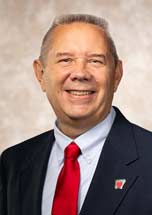
What if the key to rescuing struggling academic programs lies hidden in the story of a near-failure turned success? At the brink of defeat, a small regional university’s Computer Science program defied the odds through strategic realignment and relentless innovation. In the article, “Optimizing Low Enrollment Program Design: Aiming for Stakeholder Success,” David Reavis from the Walton College of Business and his brother Mark Reavis (UCO) as well as Gary Stading (TAMU- Texarkana) reveal the story behind the program’s revival and offer a lifeline for other institutions facing the same fate by giving future program leaders a blueprint to follow throughout the process.
The authors’ research explores factors that influence enrollment, addressing key changes universities can make to their programming to increase enrollment. While the university requested to remain anonymous, the authors believe the program’s revival could provide critical information for those dealing with similar issues. While this research does not provide a guarantee of success for all programs, key changes such as curriculum changes, advising updates and teaching assignments can be a good start to improving any program or degree in higher education.
What is a “Low Enrollment Program?”
On September 1, 2005, the university established their computer science program. Ten years later, the Texas Higher Education Coordinating Board (THECB) conducted an annual program enrollment review. With fewer than 25 undergrad graduates in five years, the program was listed as a “Low Producing Program.” When they place programs on this list, the THECB Coordinating Board can issue recommendations for the consolidation or closure of programs that have consistently low numbers. If a program remains on the list for 3 years, it is at risk of being discontinued.
In addition to the risk of being discontinued, there are many other implications that come with being a Low Enrollment program. For instance, resource allocation is a major challenge that low enrollment programs face. With the small number of students, there can often be a mismatch in student-to-faculty ratios, leading to extremely small classes, which may be seen as an inefficient use of faculty time. Because of this, many universities do not want to pay for a faculty member who caters only to those in a small program such as this one. This mindset leads smaller programs to have an insufficient number of teachers, which increases faculty workload and lack of institutional support, both of which can make running a program more difficult.
The university reorganized its colleges in December of 2016 to address the issue of low enrollment by combining the computer science (CS) and electrical engineering programs into the existing College of Business (COB). The result was the College of Business, Engineering, and Technology. This gave the faculty the opportunity to explore potential revisions of the curriculum and pathways to completing the degree. The goals were to address the concerns of various stakeholders and ultimately work toward getting the program off the Low Producing Program list.
To make these changes, the programs leaders listened to industry representatives, university administrators, and faculty. With this, the degree program leaders were able to identify and address six specific barriers to the success of students in the CS program, many of which affect universities everywhere.
Remove Unnecessary Prerequisites
The first barrier identified was the issue of course sequencing and prerequisites. While it is not uncommon for courses at the university level to require a prerequisite, this program contained an over-abundance. Many prerequisite courses had their own prerequisites, and those courses had their own prerequisite, and so on, leading to a long, complicated list of courses that were difficult to enroll in. This led to scheduling issues and delays in course work for many students in the program.
The board examined the foundational courses of the CS program to determine what courses had a clear need for a prerequisite. If the need for one was not clear, the prerequisite was dropped. In light of this, faculty were asked to look at which vital concepts from the discontinued courses could be combined into what was left to ensure that students were still receiving the information that was important from the courses. The goal of condensing the courses and their prerequisites was to create more flexibility within student course choices and accelerate progress within the program.
Decrease Number of Elective Courses Offered
The second issue found was how often required classes were offered and course rotations. Many college students are well versed in the frustration that revolves around the frequency of required classes. Having a required class that is only offered once every two years, for example, is frustrating to say the least! If, for some reason, you are unable to take that course in your first two years of college, graduation might be delayed until you get another chance to take that course. This is especially frustrating for students who are looking to graduate early, nontraditional students, or those who are not on a typical graduation schedule.
In response to this issue, the university had to do three things: eliminate some elective courses, support adjunct hiring, and allow smaller classes. The first step was to decrease the number of elective courses offered on a regular basis. By doing this, faculty members were freer to teach required courses, meaning they were able to schedule the required courses more frequently. However, this did not solve the problem completely. In addition to eliminating some of these unnecessary courses, the university also had to take on the financial responsibility of hiring adjunct faculty and allowing smaller classes that might have been cancelled previously.
Combine Similar Courses
The next challenge was another that most students and faculty have struggled with at some point in time: schedule conflicts. These arise when two or more required courses are offered at the same time and day, meaning the student is unable to take one of the required courses. This issue, combined with course frequency issues, could lead to course delays of up to two years.
In seeking to reduce this issue, collaboration between the math and CS departments (two very similar programs in terms of course work) was encouraged to organize schedules of the required courses. This collaboration resulted in changes that removed many time overlaps for CS students. The revised curriculum also allowed for certain courses to be moved online and offered in an asynchronous format, which gave students additional flexibility to take courses without time conflicts.
Address Target Employer Skills
Another common barrier they addressed was that the curriculum did not address target employer needs. During their research, faculty and administration found that some of the instructional content focused on faculty research interests as opposed to the needs of the local employment market. While some of the course content may have been interesting, undergraduate level business courses should be designed to prepare students for the workforce by teaching content geared toward industry needs.
To remedy this problem, the university conducted a workshop where representatives from regional organizations likely to employ recent graduates were asked to review the curriculum. Attendees were asked to critique class content and offer ideas to improve the curriculum. By doing this, administration and faculty were able to revise their curriculum to better cater toward the needs of the workforce, giving students applicable knowledge and skills.
After resolving this issue, Dr. David Reavis identified these actions as some of the most impactful of the program revival. He noted that while faculty can provide insight into curriculum decisions, they still have to answer to university and state leadership. On the other hand, external partners can provide market perspectives that are unclouded by university requirements or previous curriculum, making their perspective vital for understanding employer needs.
Cross-List Courses
The fifth adjustment made was to cross-list courses. Before the redesign of the curriculum, the courses “Mobile App Development” and “Database Systems” were taught in both MIS and CS curriculum. Essentially the exact same material was being taught by two different professors in two different programs. This not only was confusing for students but also wasted faculty resources by devoting two faculty members to the same subject. Additionally, splitting (essentially) the same class into two caused very small class sizes, putting both classes at risk of cancellation due to low enrollment.
Administration was able to identify courses in which material overlapped by looking at the curriculum of both the MIS and CS programs. These courses were cross-listed when appropriate, combining these courses into one and making it available to both MIS and CS students. Subsequently, these classes became more stable in terms of class size, decreasing the likelihood of cancellation and benefiting both programs.
Simplify Advising Processes
Finally, the last barrier addressed was the complexity of advising for the CS program. The initial process for advising within this program was poorly defined and not easily understood by faculty, students, or even the professional advising staff themselves. Complex advising creates frustration across all parties as no one is clear as to what exactly the path to graduation consists of. Often, students become frustrated when they are unclear of the timeline of courses needed, leading to blaming of various parties across the board. As discussed previously, the complexity of the CS program structure required unnecessary and hidden prerequisites, unnecessary courses, and other complex issues which led to confusion and frustration.
This problem was solved by a combination of the adjustments that were made in solving the previously discussed barriers. By eliminating confusing prerequisites, unnecessary electives, scheduling conflicts, and non-practical class content and by cross-listing courses with the MIS program, the new degree plan provided a clearer pathway to graduation. This new degree plan also gave students more flexibility when scheduling courses. With a clearer path, students could easily determine what classes were needed and were able to register for more classes without prerequisite approval, leading to less convoluted paths to graduation.
Results
In 2019, the CS program was finally removed off the Low Producing Program list. The 5-year average number of graduates reached 5.2, which was a significant increase from 3.4 in 2015 with only 19 graduates that year. Today, the number of graduates continues to increase. In 2022, the program reached 72 graduates and has only continued to climb in years after!
This research offers valuable insights for other universities facing similar challenges with low enrollment programs. By adopting similar approaches such as reorganizing programs and addressing specific barriers, other institutions can enhance the effectiveness and sustainability of their own programs. This study serves as a road map for other universities, explaining how to create a supportive, successful environment for both students and faculty, ultimately leading to higher enrollment and graduation rates.
 Kaslyn Tidmore is a second-year graduate student at the University of Arkansas, earning
her master’s degree in public relations and advertising. Before relocating to Arkansas,
Kaslyn graduated from the University of Oklahoma with a bachelor’s degree in print
journalism and a minor in editing and publishing. During this time, she interned with
publications such as, Parker County Today Magazine, WedLinkMedia, Modern Luxury, and
the school’s newspaper, the OU Daily. Following her role as the graduate assistant
to Editor-in-Chief Ryan Sheets, Kaslyn now serves as a GA in the Center for Media
Ethics and Literacy at the School of Journalism and Strategic Media.
Kaslyn Tidmore is a second-year graduate student at the University of Arkansas, earning
her master’s degree in public relations and advertising. Before relocating to Arkansas,
Kaslyn graduated from the University of Oklahoma with a bachelor’s degree in print
journalism and a minor in editing and publishing. During this time, she interned with
publications such as, Parker County Today Magazine, WedLinkMedia, Modern Luxury, and
the school’s newspaper, the OU Daily. Following her role as the graduate assistant
to Editor-in-Chief Ryan Sheets, Kaslyn now serves as a GA in the Center for Media
Ethics and Literacy at the School of Journalism and Strategic Media.




